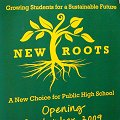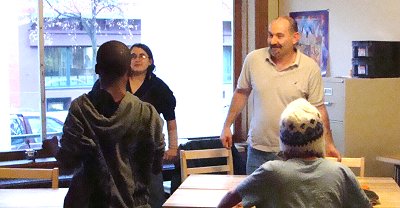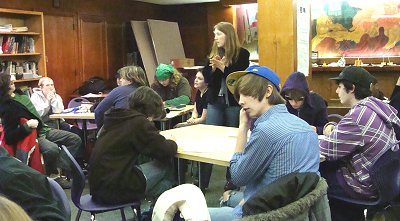- By Dan Veaner
- Around Town
 Print
Print  Part 2: Building a School
Part 2: Building a School| Last week we presented an inside look at New Roots Charter School. This week we report on how the school has been created. Part 1: Inside New Roots Part 2: Building a School Part 3: New Roots' Impact | ||
10th Grade math teacher Jayson Rome says that spending that time focusing on community building was key to making the curriculum work. He says that building a positive school culture and building a foundation for empowering students to have a voice in how they will learn is what seems to make the whole system work. "If they don't get along, there is no curriculum," he says.
This summer faculty and administrators were faced with the daunting task of creating a school very quickly from nothing. This wasn't Micky Rooney telling Judy Garland, "Hey Judy, let's put on a play." It was more like the birth of Athena as she was born full blown from the brow of Zeus. It was the seemingly instant creation of a one-school school district with challenges that range from creating a curriculum to setting a schedule, to literally building classrooms in a historic downtown building. All the things district schools take for granted had to be created from scratch.
That included training for the faculty, and planning the expeditionary learning curriculum, making connections with local organizations and businesses, building a farm to school program -- all that while recruiting the first year's freshmen and sophomores. The first trimester was the testing ground, and while the school as a whole seemed to gel, not everything went smoothly. But the school community paid attention to what was working and what wasn't and proved remarkably responsive when parents and students brought glitches to school officials' attention.

The second trimester schedule represents a major overhaul after paying attention to lessons learned in the first. Average class sizes have been reduced from about 20 to around 15. Crew -- a kind of combination of homeroom and a mentoring environment -- has gone down to about ten students so that each can receive more personal attention. An electronic 'school bell' system has been purchased that will synchronize beginning and ending classes, making more productive use of time.
"I've come to appreciate the amount of time that it takes for schools to establish foundational systems that can be taken for granted at some point," Nilsen-Hodges says. "We are experiencing that same fuzziness in some places. For instance figuring out our snow policy -- in established schools it's just established, and for the geographical area you are in it's not that hard. But how do you factor in 14 different school districts and all the transportation patterns for a regional school like New Roots? It requires a whole lot of brain power that established schools don't have to expend on any given issue."
One of the reasons New Roots has been successful is that they use the 'brain power' not only of administration and staff, but of students and parents as well. Formal and casual suggestions are listened to and taken seriously. When you talk to New Roots teachers, parents, and students you hear over and over again how the students have an active voice in creating their school, and more importantly the culture of their school, and the stress on respect for diversity and each other has made for a remarkably homogenous student body.
"They need to give us feedback," Rome says. "They need to tell us what their experience is on the ground. Plus we have a wide range of learning styles, abilities, and backgrounds, so we have to listen to them, or those kids will end up bored or struggling."
Principal Tina Nilsen-Hodges adds that coming from such a variety of school cultures including different school districts, alternative schools, and home schooling, with the varying expectations and preparation each provides has sometimes made it difficult to help kids wrap their minds around the New Roots culture.
"One of our biggest challenges is supporting the students in making the transition from the patterns and habits and ways of coping with their past school culture and stepping into something completely different here," says Nilsen-Hodges. "Because it is not an established culture yet -- we're working on establishing it together -- we don't have seniors who are mentoring new students coming in. Everybody's working on to create this together, but everybody is bringing in all of their old assumptions and patterns. Particularly when you're talking about schools everyone is going to have a wide variety of ways they have coped with their prior school settings, and they bring expectations about what school is."
The differences, of course, aren't all cultural. Students had to adapt to an entirely new approach to learning. Expeditionary Learning was developed by the Outward Bound program when it originated in Great Britain in 1941. The program came to the U.S. in 1961. The idea is to bring experiences into the classroom from field trips and internships, and to incorporate teamwork, courage, craftsmanship, perseverance, and compassion. With experiences outside the classroom providing context for those within, and with connections made between learning topics, classroom material becomes more relevant.
A school that is so different from expectations has turned out to be just right for some students. For others it is too different and they have returned to their home districts. The 10th grade class has diminished somewhat, perhaps because kids who went through a year of traditional high school developed a stronger notion of 'what high school is' than 9th graders entering high school for the first time.
One thing that is keeping students at New Roots is the virtually universal feeling that students are being listened to, and that what they think really matters. This has had a profound influence on the culture of the school, and apparently gives students a 'buy-in' that motivates them to do better.

"They're really starting to understand that they are running this school in a positive way," Rome says. "I think a lot of kids in high school try to run it. Here we're saying 'Yes, we want you to run it. We want you to help us create the school you need.' And a lot of them are stepping up with suggestions. If I can figure out how to formalize those suggestions and get them into peoples' hands they'll be heard. That's a new experience for a lot of people."
From the beginning school officials promised students would have an active role in 'founding' their school. Students are encouraged to provide feedback on how things are done, on rules and discipline -- every aspect of the school. Each crew has a student council representative. When suggestions are made that provides a formal conduit for the idea to work its way up through the council to the administration. Many of these ideas have been implemented and students are empowered when they see positive suggestions actually implemented.
"A lot of the students are really starting to realize they can say 'This isn't working for me and can I suggest this?' rather than just saying 'This sucks,' which is a more normal response," Rome says. "I allow them to criticize, but if you're going to criticize you've got to come up with a proposal. And if you give me more we'll bring a proposal to the student council. The student council is very effective. They'll bring it to the administration, and several proposals have already been adopted that way."
Parents also find faculty very responsive in ways that can be surprising when you are used to parenting a child in a traditional school. Teachers reach out to parents regularly, sometimes even on Sundays, in an attempt to keep them informed about their children's progress and partner with them to help their kids succeed. When a child stumbles teachers listen to parents' take on why that happened and respond with new procedures for helping that child succeed. Suggestions from parents are treated respectfully. Many are implemented, sometimes very quickly.
"What is wonderful about this time right now is that we're also realizing the vision of having all our different stakeholders involved in the process of creating them," she says. "Kids are involved through crews, and the representative student council model. They are taking on school policies, making recommendations to faculty that are instituted as solutions to issues that have arisen. We're developing a parent and care giver association. All of those different parts are coming together. That's a very satisfying piece of what we see gelling at this time."
As the school is figuring out its first year it also has to plan for next year, when its population will be half again as high. The state has awarded New Roots a $235,000 state grant for sprinklers to bring the second floor up to code to allow classrooms there. The Kitchen Theatre is scheduled to leave the Clinton House in April. Until then the lobby space is shared, which means that at least one classroom is defined by walls on wheels, and the main entry desk is also on wheels so the space can be a theater lobby for performances. When the theater moves to its own building the current space will be converted to classrooms.
"This is a great location," Nilsen-Hodges says. "It's a beautiful building. The kids really like that it's a building with history and with meaning. We're right here in the heart of downtown. It's been amazing to very quickly realizing our vision of having kids getting our for field work very easily on the TCAT busses, kids doing internships in a variety of local businesses and organizations from child care, preschools, to a young woman who is baking bread at Oasis, to another young man who is apprenticing at a car repair shop."
School Districts have administrative teams. Including teachers, the entire staff numbers around 20 people this year. With the addition of a junior class next year and a senior class the following year the teaching staff will grow. New Roots is a one-school district with Nilsen-Hodges filling the roles of superintendent as well as the principal. The Board of Trustees is the equivalent of a school board. The school has a very small administrative staff, that must fulfill all the functions a larger district staff would.
"I find it challenging to be the principal of the building, but also the superintendent who has to oversee the larger processes as well," Nilsen-Hodges. "And making sure that I'm attending to both of those well."
That might account for she school's ability to adapt so quickly, because individuals responsible for the big picture are also dealing with day to day issues. Those people seem to have an uncanny knack for inviting everyone involved in the school to contribute ideas.
One of the things that is ongoing for New Roots is recruiting students. Recruiting this year's class presented the interesting challenge of getting people to commit their children to coming to a school that didn't yet exist. Now that the school has an actual presence Nilsen-Hodges is optimistic that recruiting will be easier. She says that families who may have been on the fence about the school now can actually look at a real school and decide whether it is right for their child.
While tending to the schools future and present needs, she also takes time to visit the classroom and engage with the students. Teachers share her enthusiasm for the extent to which the kids have stepped up and embarced their education at New Roots.
"I love the kids," Rome says. "The kids are amazing. You put this dynamic group together and really amazing things happen."
"I am having a good time," agrees science teacher Becca Rodomsky-Bish. "I love my students very, very much. We all have hard days, but in general these kids are great. And they're coming around. I think that for a lot of students that hadn't been exposed to an alternative or were from more of a traditional school there is more acting out that goes on, because they're trying to figure out how to learn in an environment that caters to learning in a different way. But we're starting to see those students turn the corner. And ultimately my desire as a teacher is that my students are having fun and are engaged in learning. When I go home knowing that at the end of the day it makes me feel really good."
Next Week: New Roots' Impact
----
v6i2



